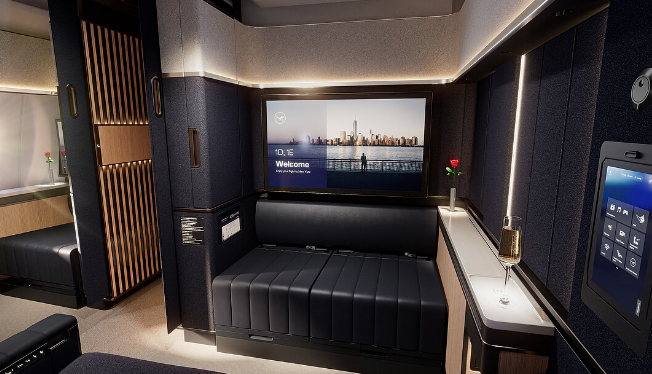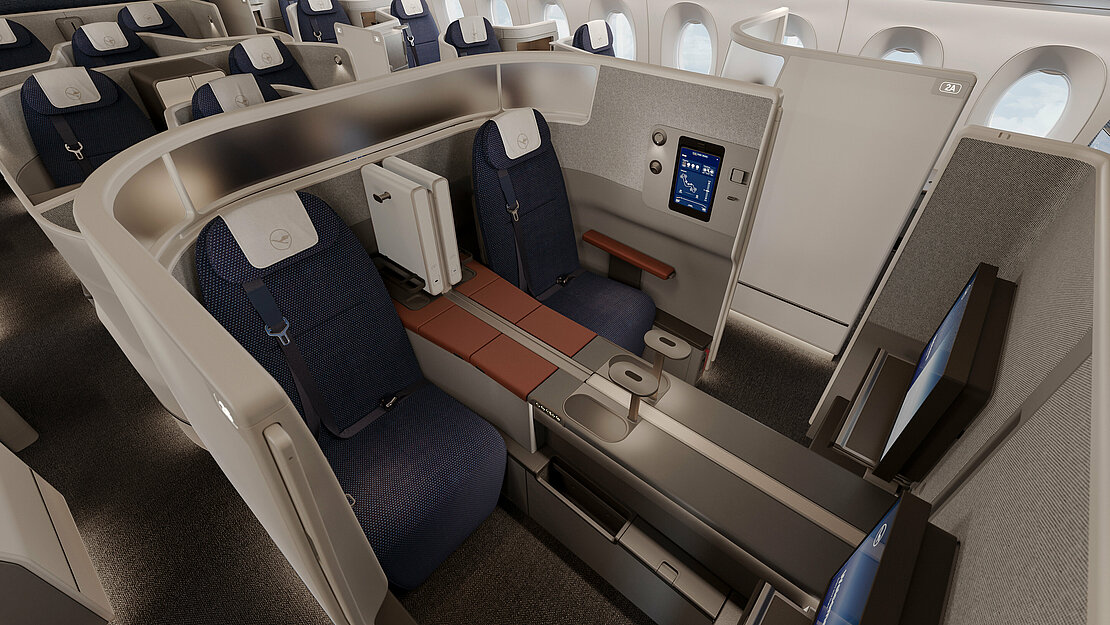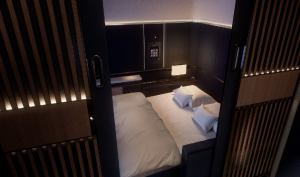Lufthansa is expanding its premium First Class offering with the “Suite Plus,” a separate double cabin with ceiling-high walls and an entirely closable door, large table and two wide seats that can be combined into a comfortable double bed if required.
With this flying private room, Lufthansa is setting a new standard in comfort and individuality within its most sophisticated travel class.
The First Class Suite’s features are unparalleled anywhere in the world: Guests can warm or cool their nearly one-meter-wide seats in the suite according to their personal needs and connect their own mobile device to the entertainment system. Ample storage space is provided by a suite wardrobe so that travelers can comfortably change and have all their personal belongings at hand.
Service at the highest level also awaits: The crew serves the gourmet menu at a time requested by the guests. The meal can be enjoyed in the private suites at the large First Class table, similar to a restaurant.
“Lufthansa Allegris”
The First Class will be introduced in 2024, on the newly delivered Airbus A350s as part of “Lufthansa Allegris,” the airline’s new long-haul product. In the process, the company is improving the overall travel experience for customers in all travel classes: Economy, Premium Economy, Business and First Class. “Allegris” is part of the largest product and service overhaul in the Lufthansa Group’s history, with a total investment of 2.5 billion euros by 2025.
“Every guest has their own understanding of premium, which is why we focus on maximum individuality and exclusivity. The First Class Suite Plus conveys the feeling of privacy and individuality similar to a hotel room – only at an altitude of eleven kilometers,” explained Jens Ritter, CEO Lufthansa Airlines at the launch of the “First Class Suite Plus” on February 28 in Berlin. “The Allegris range promises individuality, exclusivity, and premium service along the entire travel chain.”
Business Class: More flexible than ever
For the first time, guests in Lufthansa Business Class can also look forward to their own suite, which offers even more comfort and privacy due to chest-high walls and sliding doors. Here, travelers in the first rows can enjoy extended personal space, a monitor up to 27 inches in size and ample storage. Each suite also offers its own wardrobe and personal minibar. Inside, it is possible to connect the two suites so that business class guests traveling together can enjoy a large degree of privacy.
With “Allegris,” the freedom of choice for Business Class guests has never been greater. Travelers can choose between six additional seat options, depending on whether they want an extra-long bed measuring 2.20 meters, extra space and work area, a seat with a baby bassinet, or simply an exclusive seat directly by the window. A double seat, in which the center console can be retracted to transform it into a reclining surface for two, is alsoavailable.
High seat walls and generous shoulder space provide greater privacy in all options. The seats can be converted into a bed at least two meters long and also offer high-definition screens (4K), generously-sized dining tables, wireless charging, noise-canceling headphones and Bluetooth connectivity. All seats are also equipped with a heating and cooling system, giving business class travelers the flexibility to set their own temperature. For extra comfortable side sleeping, seats also feature a shoulder sink-in, allowing the shoulder to sink into the seat, increasing sleeping comfort for side sleepers. A tablet-sized control unit provides access to all seating, lighting, heating/cooling and entertainment functions. Naturally, each seat is directly accessible from the aisle.

Premium Economy and Economy: more space, more choice
The new Premium Economy Class has already been introduced at SWISS in spring 2022. The “Allegris” seat offers more legroom, a fold-out leg rest, and can be adjusted even further back than the current model. Because it will be integrated into a hard shell, however, adjusting it will have no effect on fellow passengers in the row behind. The table and monitor always remain in position. For more comfort, Premium Economy Class passengers will also receive a travel amenity kit made of sustainable materials.
With the new “Allegris” product generation, Lufthansa is also giving its guests significantly more choice in Economy Class. In the future, travelers will have the option of booking additional seats in the first rows that offer more legroom, or a free seat next to them.

“Allegris” brings new aircraft to Lufthansa
With “Allegris”, more than 80 brand-new Lufthansa aircraft, such as Boeing 787-9s, Airbus A350s and Boeing 777-9s, will fly to destinations around the world. Aircraft already in service with Lufthansa, such as the Boeing 747-8, will also be retrofitted. The simultaneous improvement of the travel experience in all classes and the replacement of more than 27,000 seats are unique in Lufthansa’s history. In this way, the company is underscoring its clear premium and quality claim. By 2025, the Lufthansa Group will invest a total of 2.5 billion euros in product and service.
Part of a sustainable overall concept
Simultaneously, the Lufthansa Group is in the midst of the largest fleet modernization in its corporate history. By 2030, more than 200 new short- and long-haul aircraft are to be delivered to the Group’s airlines. This will enable the Lufthansa Group to significantly reduce the average CO2 emissions of its fleet. The ultra-modern “Dreamliner” long-haul aircraft, for example, will consume an average of only about 2.5 liters of kerosene per passenger and 100 kilometers of flight distance— up to 30 percent less than the previous model.
The developers also focused on sustainability aspects in the product development of “Allegris”. Recyclable materials were used for all 27,000 seats, as well as for blankets, cushions and covers.
The Lufthansa Group has set itself ambitious climate protection goals and aims to achieve a neutral CO₂ balance by 2050. Already by 2030, the aviation group wants to halve its net CO₂ emissions, compared to 2019, through reduction and compensation measures. The reduction roadmap to 2030 was validated in 2022 by the independent Science Based Targets Initiative (SBTi).
























